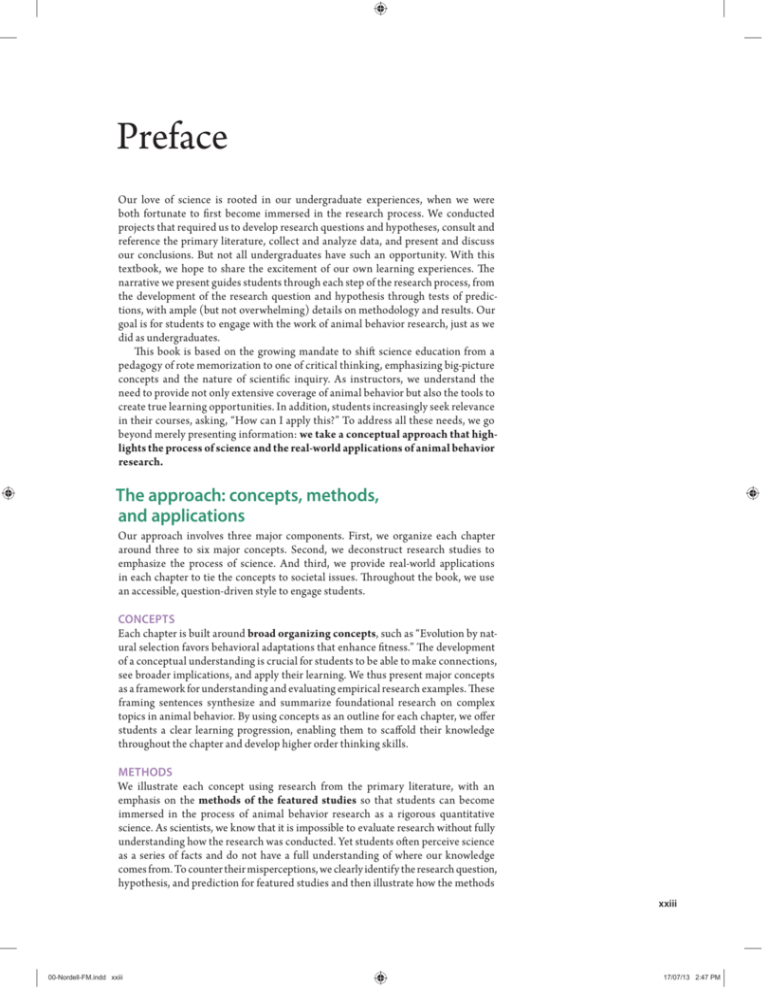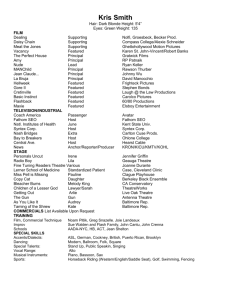Preface
advertisement

Preface Our love of science is rooted in our undergraduate experiences, when we were both fortunate to fi rst become immersed in the research process. We conducted projects that required us to develop research questions and hypotheses, consult and reference the primary literature, collect and analyze data, and present and discuss our conclusions. But not all undergraduates have such an opportunity. With this textbook, we hope to share the excitement of our own learning experiences. The narrative we present guides students through each step of the research process, from the development of the research question and hypothesis through tests of predictions, with ample (but not overwhelming) details on methodology and results. Our goal is for students to engage with the work of animal behavior research, just as we did as undergraduates. Th is book is based on the growing mandate to shift science education from a pedagogy of rote memorization to one of critical thinking, emphasizing big-picture concepts and the nature of scientific inquiry. As instructors, we understand the need to provide not only extensive coverage of animal behavior but also the tools to create true learning opportunities. In addition, students increasingly seek relevance in their courses, asking, “How can I apply this?” To address all these needs, we go beyond merely presenting information: we take a conceptual approach that highlights the process of science and the real-world applications of animal behavior research. The approach: concepts, methods, and applications Our approach involves three major components. First, we organize each chapter around three to six major concepts. Second, we deconstruct research studies to emphasize the process of science. And third, we provide real-world applications in each chapter to tie the concepts to societal issues. Th roughout the book, we use an accessible, question-driven style to engage students. CONCEPTS Each chapter is built around broad organizing concepts, such as “Evolution by natural selection favors behavioral adaptations that enhance fitness.” The development of a conceptual understanding is crucial for students to be able to make connections, see broader implications, and apply their learning. We thus present major concepts as a framework for understanding and evaluating empirical research examples. These framing sentences synthesize and summarize foundational research on complex topics in animal behavior. By using concepts as an outline for each chapter, we offer students a clear learning progression, enabling them to scaffold their knowledge throughout the chapter and develop higher order thinking skills. METHODS We illustrate each concept using research from the primary literature, with an emphasis on the methods of the featured studies so that students can become immersed in the process of animal behavior research as a rigorous quantitative science. As scientists, we know that it is impossible to evaluate research without fully understanding how the research was conducted. Yet students often perceive science as a series of facts and do not have a full understanding of where our knowledge comes from. To counter their misperceptions, we clearly identify the research question, hypothesis, and prediction for featured studies and then illustrate how the methods xxiii 00-Nordell-FM.indd xxiii 17/07/13 2:47 PM xxiv Preface allow the prediction to be tested. We present the resulting data in a way that shows students the individual variation present in all data. For example, we present means with standard errors in many of the results figures in the book. The book also offers a detailed chapter on standard methodology used in animal behavior research. The featured studies have been carefully chosen to represent a broad range of taxa and include a combination of classic and contemporary research that is student accessible. We introduce the researchers from each study using their full names so that students can appreciate not only the diversity of taxa studied but also the diversity of researchers. APPLICATIONS Each chapter contains examples of how various people and groups are applying the concepts in animal behavior research to societal problems and issues. Students rarely have the opportunity to see how animal behavior research might be relevant to their own lives. Yet there are many applications of this field, such as how habitat selection behavior is being used to more effectively reintroduce species to restored areas or how crop damage can be mitigated by manipulating predation risk. Th roughout the book, we highlight these examples in the “Applying the Concepts” feature. Overview of chapters The fi rst three chapters lay the groundwork for understanding the science of animal behavior. In Chapter 1, we provide a brief review of the scientific method. Chapter 2 presents an overview of evolution, and Chapter 3 summarizes methods commonly used to study behavior and presents a historical review of the field. The next two chapters focus on the development of behavior through the examination of behavioral genetics (Chapter 4) and learning and cognition (Chapter 5). We then examine communication (Chapter 6), foraging (Chapter 7), and antipredator behavior (Chapter 8). Chapter 9 is devoted to animal movement, taking a look at both dispersal and migration. In Chapter 10, we cover habitat selection, territoriality, and aggression. The next three chapters focus on reproduction, examining mating behavior (Chapter 11), mating systems (Chapter 12), and parental care (Chapter 13). We end with a chapter devoted to social behavior (Chapter 14). Although the book contains chapters that differentially emphasize proximate and ultimate explanations of behavior, we infuse both approaches throughout the chapters by the incorporation of Tinbergen’s four questions. Teaching and learning features • • 00-Nordell-FM.indd xxiv “Scientific Process” boxes: To further emphasize the process of science, each chapter contains one to three “Scientific Process” boxes. These present detailed research descriptions within a scientific framework, clearly and concisely laying out each step: research question, hypotheses, predictions, methods, results, and conclusions. Students can thus easily follow the research example at a glance, from its conception (the original research question) to the use of the scientific method (the creation of testable hypotheses, the experimental protocol used, the evaluation of data) and ultimately the fi ndings of the work (conclusions of the study). The details contained in these examples illustrate and reinforce the rigorous nature of animal behavior research. “Toolboxes”: These boxes explain essential skills or complex terms in the science of animal behavior. They do not appear in every chapter but are included as needed to build students’ intellectual toolkit. They have two functions. First, these boxes show students how they can apply the scientific concepts to their own work. For example, one toolbox describes animal 17/07/13 2:47 PM Preface • • • • xxv sampling techniques because we know that many students will be asked to collect data as a part of this course. Second, toolboxes provide additional background information. For instance, many students may lack knowledge about phylogenies, which is crucial for employing the comparative method in behavior research. Therefore, one toolbox provides information describing phylogenies, how they are constructed, and how they are interpreted. Another toolbox explains how data are described and summarized to help students understand the data presented throughout the book. “Applying the Concepts” boxes: These boxes, which appear in each chapter, contain examples of how animal behavior research is being applied to reallife problems. Th is feature shows students the importance and relevance of “pure” scientific research to larger societal problems. By including these boxes in every chapter, we give students opportunities to see the broader implications and importance of research. “Chapter Summary and Beyond”: At the end of each chapter, we provide a brief summary of the concepts covered. In doing so, we also point students to recent papers that further develop the ideas presented in the chapter. No textbook can be all-inclusive, so these papers are ideal for students or instructors seeking additional information about a concept. Chapter questions: At the end of each chapter, we provide a range of questions, including some that could be used as assignments, to promote critical thinking and foster class discussions. Answers and notes for evennumbered questions are included at the back of the text so that students can test themselves, and answers and notes for odd-numbered questions are included in the instructor’s resources. Diverse research examples: The book contains research examples covering a diverse range of taxa from all over the world. We have consciously worked to include ample representation from major taxa (invertebrates, amphibians, reptiles, fish, birds, and mammals) in each chapter. Because most students have a limited knowledge of animal diversity, we have included an image of each featured research species in addition to brief natural history descriptions. (Furthermore, over 300 additional photos are available on the Instructor’s Resource CD and the companion website, www.oup.com/us/ nordell, which we describe in the following section.) We also include data summary figures as they typically appear in the primary literature. Thus, students can see that variation in behavior is ubiquitous in research: individual data points are plotted on line graphs, and bar graphs contain means with standard error bars. Support package Oxford University Press offers a comprehensive ancillary package for instructors who adopt Animal Behavior: Concepts, Methods, and Applications. The following resources are available on the Instructor’s Resource CD and the companion website, www.oup.com/us/nordell: • Video library and guide: To help students better understand animal behavior research and visualize the science in each chapter, and to provide instructors with an easy-to-use resource for videos tied directly to the concepts covered in the text, we have assembled links to three types of short videos: 1. Natural history videos that illustrate specific behaviors of the study organisms in the featured studies 2. Process-of-science videos that illustrate the methodology described in featured research 3. Interviews with the scientists whose research is featured in the book 00-Nordell-FM.indd xxv 17/07/13 2:47 PM xxvi Preface • • • • • We have carefully selected these videos because animal behavior is a visual endeavor, and yet students often have litt le experience with the diversity of taxa studied or their behavior. Each video link is accompanied by a brief description of its content and information on the video’s length. We envision that instructors will incorporate many of these videos into their classes to help students better understand the behavior and research of animals. Digital image library: The image library includes electronic fi les in PowerPoint format of every illustration, graph, photo, figure caption, and table from the text, in both labeled and unlabeled versions. Images have been enhanced for clear projection in large lecture halls. The library also includes more than 300 additional photos from researchers, depicting study organisms, research protocol set-ups, researchers collecting data, and habitats. For each chapter, we provide these photos and a guide to their content so that instructors can easily incorporate them into their courses. Lecture notes for each chapter: Editable lecture notes in PowerPoint format make preparing lectures faster and easier than ever. Each chapter’s presentation includes a succinct outline of key concepts and featured research studies, and incorporates the graphics from the chapter. Test bank: We have created a test item fi le that includes over 250 multiplechoice questions suitable for exams (available only on the Instructor’s Resource CD as a Word document). Suggested further readings: To assist instructors in identifying classic, contemporary, and relevant readings from the primary literature, we have assembled a list of over 25 suggested further readings taken directly from the journal Behavioral Ecology. These readings, like the video library, are tied directly to the concepts covered in the text. In addition, we provide a pedagogical guideline to help students develop their ability to critically evaluate the primary literature. Answers and notes (for odd-numbered chapter questions) Contact your local OUP sales representative for a copy of the Instructor’s Resource CD and access to the companion website. Acknowledgments Th is book is the product of our rather long collaboration in both the academic sphere and life outside of academia, but we have many people to thank for providing us with immense support. We thank our scientific mentors who helped us develop our love and understanding of science. For Shawn, this group includes her Master’s advisor, Donald Thomson, who introduced her to the wonderful world of field research, and her Ph.D. advisor, Astrid Kodric-Brown, who taught her critical thinking without being critical. For Tom, this group includes his undergraduate advisor, Tom Caraco, who introduced him to the wonderful science of animal behavior, and his Ph.D. advisor, Michael Rosenzweig, who taught him how to be a scientist. Shawn would also like to thank her pedagogical mentor, Mary Stephen, director of Saint Louis University’s Reinert Center for Teaching Excellence, who helped her develop her understanding of and research on the scholarship of teaching and learning. We would both like to thank our many, many wonderful students who graciously provided constructive feedback and input regarding our teaching and their learning of our favorite discipline. We also thank our Saint Louis University colleagues for their support throughout the process, particularly the Department of Biology, Don Brennan, and Joe Weixlmann. Finally, we thank Robin Carter, Scott Freeman, Sallie Marston, Manuel Molles, and Bob Ricklefs for sharing their wisdom and advice regarding the world of writing textbooks. We also wish to express our deep appreciation to the wonderful team at Oxford University Press USA who guided us through this project: Jason Noe, senior editor, 00-Nordell-FM.indd xxvi 17/07/13 2:47 PM Preface xxvii who somehow convinced us we should and could write this book and guided us graciously through the process; John Haber, developmental editor, who in a most affable manner taught us the fi ne art of clarity in writing and provided continuous good humor despite missed deadlines; Lauren Mine, developmental editor, who provided great insight and attention to details to ensure our vision was realized; Shelby Peak, production editor, for meticulously shepherding the manuscript through copy editing and typesett ing; Melissa Rubes, Katie Naughton, Caitlin Kleinschmidt, and Andrew Heaton, editorial assistants, for conscientiously following up on so many details; Jason Kramer, marketing manager; Frank Mortimer, director of marketing; Patrick Lynch, editorial director; and John Challice, vice president and publisher. We also wish to thank those in production and design who worked so hard to make this such a beautiful book: Kim Howie, senior designer; Michele Laseau, art director; Lisa Grzan, production manager; and the team at Precision Graphics. We could not have completed this project without the amazing and continued support and encouragement of our dear friends and family. We thank our friends in St. Louis (especially Vera and Joe Brandt, Bob and Caroline Cordia, Jean and Bill Curtis, Diane and Frank Lockhart, Sharon Matlock, Denise Mandle, and Chris Sebelski) and Tucson (especially Ellen Tutt le, Marcy Tigerman, Marcy Wood), for whom we express great love and gratitude. Their unfailing enthusiasm was appreciated more than we can ever say and helped us through many deadlines. We also thank our families both past and present, who supported our endeavors with love and appreciation. Shawn would like to thank her Academic Ladder Writing Club group members, who supported her writing on a daily basis. Finally, we thank Buck, Ernie, Kirby, Grace, and Max, whose boundless energy and wagging tails kept us smiling and have taught us more about animal behavior than they will ever know. We thank the following reviewers, commissioned by Oxford University Press, for providing thoughtful and constructive suggestions. The book benefited greatly from their skillful input: Elizabeth Archie, University of Notre Dame Suzanne Baker, James Madison University Peter Bednekoff, Eastern Michigan University Russell Benford, Northern Arizona University Andrew R. Blaustein, Oregon State University Joel Brown, University of Illinois at Chicago Theodore E. Burk, Creighton University Prassede Calabi, University of Massachusett s–Boston Blaine Cole, University of Houston Francine Dolins, University of Michigan–Dearborn Richard Duhrkopf, Baylor University Emily DuVal, Florida State University Fred C. Dyer, Michigan State University Janice Edgerly-Rooks, Santa Clara University Miles Engell, North Carolina State University Ann Fraser, Kalamazoo College 00-Nordell-FM.indd xxvii Sharon Gill, Western Michigan University Harold Gouzoules, Emory University Blaine D. Griffen, University of South Carolina Sylvia L. Halkin, Central Connecticut State University Jodee Hunt, Grand Valley State University Valerie James-Aldridge, University of Texas–Pan American Clint Kelly, Iowa State University Astrid Kodric-Brown, University of New Mexico William Kroll, Loyola University Chicago David Lahti, Queens College Tracy Langkilde, Pennsylvania State University Susan Lewis, Carroll University Catherine Lohmann, University of North Carolina at Chapel Hill Jeff Lucas, Purdue University Karen Mabry, New Mexico State University John C. Maerz, University of Georgia 17/07/13 2:47 PM xxviii Preface Tara Maginnis, University of Portland Frank F. Mallory, Laurentian University Mary Beth Manjerovic , University of Central Florida Lauren Mathews, Worcester Polytechnic Institute Marion McClary, Fairleigh Dickinson University Kevin J. McGraw, Arizona State University Daniela Monk, Washington State University Cy L. Mott, Kentucky Wesleyan College James Nieh, University of California, San Francisco Brian Palestis, Wagner College Daniel R. Papaj, University of Arizona Stephen Pruett-Jones, University of Chicago Rick Relyea, University of Pittsburgh Lanna Ruddy, SUNY Geneseo Mike Ryan, University of Texas Debbie Schlenoff, University of Oregon Toru Shimizu, University of South Florida Joseph Sisneros, University of Washington Donald Sparling, Southern Illinois University Eric Strauss, Loyola Marymount University Thomas Terleph, Sacred Heart University Kevin Theis, Michigan State University Jeff rey Thomas, Queens University of Charlotte Robert M. Turnbull, University of Southern Mississippi–Gulf Coast Al Uy, University of Miami E. Natasha Vanderhoff, Jacksonville University Sean Veney, Kent State University Margaret Voss, Penn State University David Westneat, University of Kentucky Michele Jade Zee, Northeastern University We also thank the following people for generously providing images and/or videos: Maria Abate, Mark Abrahams, Elizabeth Adkins-Regan, Ginger Allington, Esteban Alzate, Nick Barber, Anders Berglund, Thore Bergman, Jay Biernaske, Eric Bollinger, Th ierry Boulinier, Alice Boyle, Jacob Bro-Jorgenson, Jason Brown, Valerie Bugh, Kevin Burns, Rhett Butler, Joanne Cable, Colin Chapman, Mark Chappell, Karen Cheney, Nikita Chernetsov, Aurelie Cohas, Aaron Corcoran, Isabelle Côté, Jillian Cowles, Susan Crowe, Herman Dierick, Niels Dingemanse, Hannah Dugdale, Jeffery Dunk, Doug Eifler, Josh Engel, Brad Fiero, Benjamin Fitzpatrick, Leonard Freed, Nicole Gerlach, Eric Gese, Matt Goff, James Grant, Kristine Grayson, David Green, Simon Griffith, Benoit Guénard, Beth Hahn, Jens Herberholz, Samantha Hilber, Chad Hoefler, Anne Houde, David Jamison, Julie Jaquiéry, Trevor Jinks, Jörgen Johnsson, Clement Kent, Alan Krakauer, Jens Krause, Ipek Kulahci, Kevin Laland, Jeff rey Lane, Bernd Leisler, Bill Leonard, John Lill, Adeline Loyau, Lauren Mathews, John McCormack, Mark McCormick, Randolf Menzel, Don Miles, Matt hew Mitchell, Carson Murray, James Nichols, Justin O’Riain, Alvaro Palma, Luis Pardo, Lorna Patrick, Irene Pepperberg, Nigel Raine, Leeann Reaney, Diana Reiss, Raleigh Robertson, Helen Rodd, Kenneth Ross, Tiffany Roufs, Yvan Russell, Ralph Saporito, Gabriele Schino, Ingo Schlupp, Kenneth Schmidt, Peggy Sherman, Dominique Sigg, Hans Slabbekoorn, Marla Sokolowski, Verônica Th iemi Tsutae de Sousa, Geoff rey Steinhart, Bård Stokke, Paul Switzer, Ryan Taylor, Fabricio Barreto Teresa, Barbara Tiddi, George Uetz, Cock Van Oosterhuit, Michael Ward, Patrick Ward, Brandon Wheeler, Jan Wijmenga, Henry Wilbur, Gerald Wilkinson, Steve Yanoviak, and Mai Yasué. We appreciate your constructive feedback. Please e-mail us your thoughts at shawn.nordell@gmail.com. Shawn E. Nordell Thomas J. Valone 00-Nordell-FM.indd xxviii 17/07/13 2:48 PM







